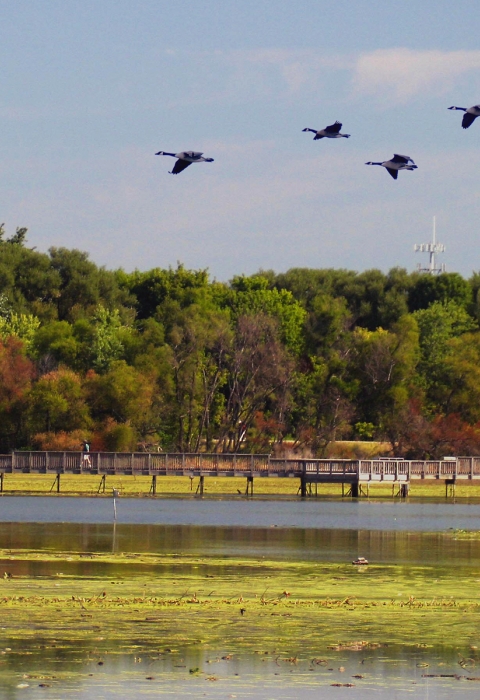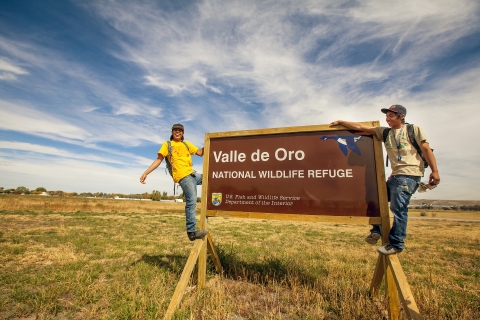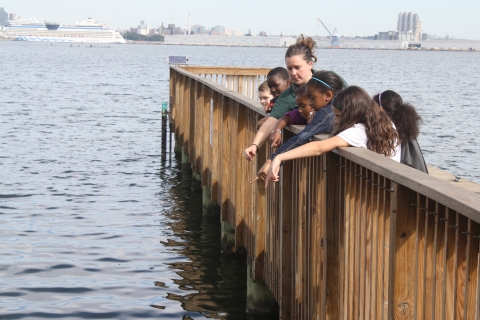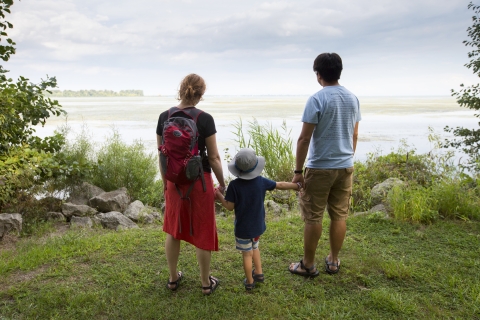The second Saturday of October marks Urban Wildlife Conservation Day —a time to celebrate our connections to the outdoors and inspire people from all walks of life to experience the benefits of nature.
People thrive on nature, wherever they live. For the 80 percent of Americans who live in or near cities, urban national wildlife refuges and urban partnerships provide vital access to nature and outdoor recreation, boosting residents’ physical and psychological well-being.
More than 100 wildlife refuges, managed by the U.S. Fish and Wildlife Service, are located within 25 miles of a city of 250,000 or more people.
To celebrate Urban Wildlife Conservation Day, many wildlife refuges and partner sites hold 5K runs, nature walks, bird festivals and other outdoor public events. See a list of events planned. The events demonstrate the Refuge System’s commitment to deepening human connections with nature and protecting the thriving ecosystems we depend on.
Urban refuges and partnerships near Albuquerque, Denver, Detroit, Houston, Minneapolis, Philadelphia and many other cities offer Americans nature-based recreation, including hiking and fishing. They also foster innovative community-based solutions for wildlife conservation.
Urban Wildlife Conservation Day kicks off a week of celebration for National Wildlife Refuge Week, the second full week in October. Urban refuge partnerships and engagement efforts are coordinated year-round through the Urban Wildlife Conservation Program.
Masonville Cove Urban Wildlife Refuge Partnership
A once blighted industrial landscape in South Baltimore is now a vibrant natural oasis. Masonville Cove, on the Patapsco River, is the home of the Masonville Cove Urban Wildlife Refuge Partnership. Together, the Fish and Wildlife Service and partners work to restore and improve this site for the benefit of local communities and wildlife.
Thanks to the partnership, residents now use the cove to fish, kayak, and partake in some of the best birding Maryland has to offer. More than 250 bird species use the cove, including the first pair of nesting balding eagles ever documented in Baltimore.
Additionally, the Masonville Cove Environmental Education Center provides students of all ages with experiential learning opportunities to bring conservation to life. These include a look at Masonville Cove’s Captain Trash Wheel — a solar-powered vessel that collects and removes trash before it enters the Patapsco River’s Middle Branch.
Valle de Oro National Wildlife Refuge
Valle de Oro National Wildlife Refuge in Albuquerque, New Mexico, is the first public land site to focus on environmental and economic justice in its strategic plan. The refuge’s blueprint for wildlife restoration and community health addresses the effects of industrial pollution on the adjacent Mountain View neighborhood. Refuge partnerships with local schools, youth corps and community groups have helped build trails from a neighboring industrial neighborhood to the refuge, provide field trips for students, and build a community garden that emphasizes traditional seeds and foods.
Since 2014, refuge partnerships with groups including the Rocky Mountain Youth Corps and the Ancestral Lands Conservation Corps have employed more than 500 young people.
In collaboration with partners, the refuge hosts annual career fairs, job shadow opportunities and mentor mixers. It also supports the New Mexico Green Jobs listserv and soon will open a Center for Conservation Careers office in its new visitor center.
The Southwest’s first urban refuge, Valle de Oro was established in 2012 to protect and restore one of the largest remaining undeveloped areas along the Rio Grande in Albuquerque.
Valle de Oro strives to be an integral part of the community. With the help of partners and residents, the refuge is restoring wildlife uplands, wetlands and bosque habitats, while creating an outdoor space where families and friends can gather, learn and have fun. Ultimately, the goal is for residents to feel a sense of ownership of the refuge.
Detroit River International Wildlife Refuge
The only international wildlife refuge in North America, Detroit River International Wildlife Refuge in southeast Michigan was established by Congress in 2001 to build a sustainable future for the Detroit River and western Lake Erie ecosystems. These 6,000 acres of marshes, shoals and waterfront also provide welcome access to nature and recreation for residents of the metro Detroit area. Thanks to region-wide pollution prevention and habitat restoration efforts, the area has made an impressive environmental recovery and created places where Detroiters can fish, boat and enjoy wildlife viewing.
A new 700-foot fishing pier, owned by Wayne County Parks and co-managed by the Service, is a great spot to cast a line or enjoy views of the lower Detroit River. Or visit the new John D. Dingell Jr. Visitor Center and pack a lunch to enjoy at the picnic tables outside. (Don’t forget to take your litter out with you).
Detroit River International Wildlife Refuge is open and accessible to everyone, whether by foot, bike or kayak. The North South Trail and Detroit Heritage River Water Trail both lead directly to the Refuge Gateway, connecting millions of residents in metropolitan Detroit to this hidden gem.
John Heinz National Wildlife Refuge at Tinicum
America’s first urban wildlife refuge, John Heinz National Wildlife Refuge at Tinicum in Philadelphia leads by example. Just a few minutes away from the bustle of the Philadelphia International Airport, city residents can enjoy a tranquil place of open fields, forests and tidal marshes, where opportunities await to see all kinds of wildlife, from red foxes and river otters to great blue herons.
The refuge was established in 1972 to protect the Tinicum Marsh, which provides vital habitat for wildlife and reduces flooding in nearby communities. Today, the refuge hosts more than a quarter-million visitors each year.
John Heinz offers many outdoor recreation and education activities, from pop-up archery and guided kayaking to evening bat walks and nature photography lessons. Listening is at the heart of everything John Heinz National Wildlife Refuge does. Refuge staff consistently work to include and partner with surrounding communities that historically have been excluded.
Providence Parks Urban Wildlife Refuge Partnership
Providence Parks Urban Wildlife Refuge Partnership in Providence, Rhode Island, connects children and families with nature where they live, work and play. Providence is one of the most ethnically diverse cities in the United States and has many underserved communities that may lack the means to experience nature outside the city.
However, 90 percent of children in Providence live within 10 minutes of a park, and Providence has more than 100 city parks for residents to draw on.
The partnership has seized on this opportunity, making Providence’s abundance of green spaces a foundation for education and fun and helping communities build long-lasting relationships to the natural world. The Fish and Wildlife Service works alongside partners – includingtheCity of Providence Parks Department, the Partnership for Providence Parks, Roger Williams Park Zoo and the Audubon Society of Rhode Island – to conduct environmental education and important stewardship projects.
Developing a sense of ownership within these communities — ownership of their neighborhood green spaces and their experience in nature — is a priority for the partnership. Whether through free fishing and clamming excursions, local field trips or habitat restoration efforts, Providence Parks Urban Wildlife Refuge Partnership inspires a sense of wonder for the nature right outside our door.









